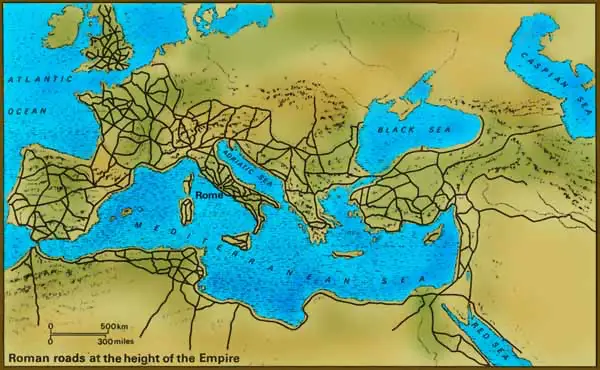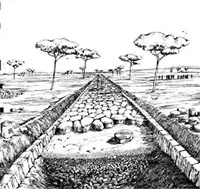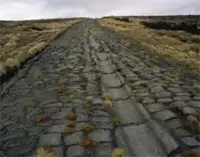Roman Roads
The ancient Romans built a vast network of roads, linking the far-flung Republic and Empire together in a unifying way that facilitated a more ready transfer of people, goods, and armies from place to place. As with other kinds of architecture, the Romans were scientific about their road-building. Roman surveyors used a groma, a set of wooden pieces in the shape of a cross that had lead weights on the ends. Lining up the weight hanging off one piece of wood with the piece hanging off the one in front guaranteed a straight line; from that, workers could put wooden posts in the ground and then build the road along the line. The Romans much preferred to build roads in a straight line, no matter what was The other primary beneficiaries of Roman roads were traders and other people doing business along the roads. The paving stones helped wagons travel in inclement weather (whereas dirt roads often turned muddy and boggy in the rain). The Romans were careful to build the road higher than the ditches that they built on either side, to force water off the road through the force of gravity. To start, soldiers would dig out a trench where the road was to go, then fill in the space with multiple layers of different materials. The soldiers would level the bare earth as much as possible, using tools known as rammers, and then cover the bare earth with the statumen, stones about the size of a human hand. On top of those would go broken stones or other kinds of rubble, including sand, if available. The nucleus, the next layer up, was a fine cement made from lime and potsherds. The Romans Most roads had curbsides on either side. Some roads had raised footpaths on one or both sides of the road. Alongside many roads were milestones, signifying distance traveled. A thousand paces (milia passuum) made up a mile; the modern equivalent is 4,841 feet. Some milestones included the distance to the endpoint of the road or to places along the way. In imperial days, some milestones included the name of the Emperor. A milestone measured was 20 inches in diameter and stood 5 feet above ground (with another two feet below ground as foundation). The Roman Empire had a mail system, which employed mail wagons or simply horsemen. Mail went from carrier to carrier in a relay system. The Romans built more than 250,000 miles of roads that criss-crossed the Empire. They were a staple of the kind of civilization that Rome brought wherever they went.  The first well-known road was the Via Appia ("Appian Way"), overseen by Appius Cladius Caesus, starting in 312 BC. The road ran from Rome to Capua, then to Tarentum, and then was extended to link to Brundusium, on the Adriatic coast, and then to the Straits of Messina. Other well-known roads included these:
|
|
Social Studies for Kids
copyright 2002–2025
David White



 underneath. They drained marshes, filled in swamps, built bridges and causeways, felled forests, excavated through rock–whatever it took to keep the road going in a straight line. One of the primary purposes of the roads was to enable soldiers to travel quickly from one place to another, and the shortest distance between two points, then as now, was a straight line.
underneath. They drained marshes, filled in swamps, built bridges and causeways, felled forests, excavated through rock–whatever it took to keep the road going in a straight line. One of the primary purposes of the roads was to enable soldiers to travel quickly from one place to another, and the shortest distance between two points, then as now, was a straight line. often used concrete in the lower layers in order to bind the materials together. On top were paving stones cut to fit tightly together. The top layer was called the pavimentum. Sometimes, the Romans cut grooves into the stones in order to ease wheeled travel.
often used concrete in the lower layers in order to bind the materials together. On top were paving stones cut to fit tightly together. The top layer was called the pavimentum. Sometimes, the Romans cut grooves into the stones in order to ease wheeled travel.
